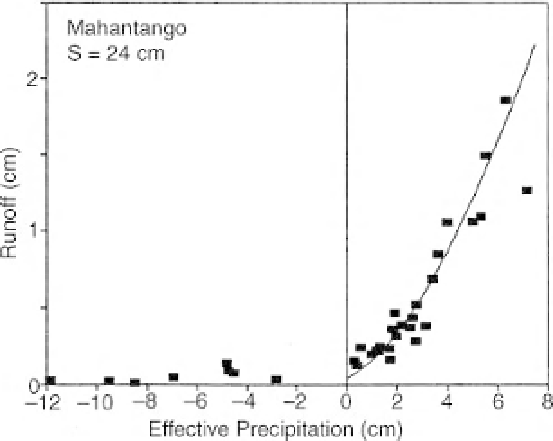Geoscience Reference
In-Depth Information
Figure B6.3.2
Application of the SCS method to data from the Mahatango Creek catchment (55 ha),
Pennsylvania (after Steenhuis
et al.
, 1995, with kind permission of the American Society of Civil Engineers);
effective rainfall is here defined as the volume of rainfall after the start of runoff.
quality and erosion models including the Areal Nonpoint Source Watershed Environment
Response System (ANSWERS; Beasley
et al.
, 1980); the Chemicals, Runoff and Erosion from
Agricultural Management Systems model (CREAMS) and its companion model for estimating
pesticide loadings to groundwater, GLEAMS (Knisel and Williams, 1995); the Simulator for
Water Resources in Rural Basins (SWRRB; Arnold and Williams, 1995); Erosion Productivity
Impact Calculator (EPIC; Williams, 1995); The Pesticide Root Zone model (PRZM; Carsel
et
al.
, 1985); the Agricultural Nonpoint Source model (AGNPS; Young
et al.
, 1995); the Water
Erosion Prediction Project (WEPP; Nearing
et al.
, 1989) and, most recently, the distributed Soil
and Water Assessment Tool (SWAT; Arnold
et al.
, 1998; Gassman
et al.
, 2007; see Box 6.2).
B6.3.5 Limitations of the Curve Number Method
It is worth remembering what is being predicted by the SCS-CN approach. It is the volume of
“storm runoff” in a given storm, after some initial retention before runoff begins, that is then
to be routed by the unit hydrograph or some other routing method to predict a storm runoff
hydrograph. It is therefore subject to all the problems and limitations associated with separating
storm runoff from the total discharge hydrograph, both in the analyses that underlay the original
model formulation and in the calculation of curve numbers for particular situations.
The curve number approach to predicting runoff generation has been the subject of a num-
ber of critical reviews (e.g. Hjelmfelt
et al.
, 1982; Bales and Betson, 1982; Michel
et al.
, 2005).
Further work is required to clarify under what conditions the method gives good predictions.
Mishra and Singh (1999) show that their generalised version of the method, Equation (B6.3.6)
gives better results than the original formulation (with
=
0), as it should, since
it has two additional fitting parameters. Hjelmfelt
et al.
(1982) suggest that the curve number,
rather than being considered as a characteristic for a given soil-land cover association, might
better be considered as a stochastic variable. Their analysis, of the annual maximum storms for
two small catchments in Iowa, suggested that the storage capacity parameter,
S
max
, derived for
individual storms was approximately log normally distributed with a coefficient of variation of
the order of 20%. The 10% and 90% quantiles of the distributions corresponded well to the
0
.
2 and
a
=


